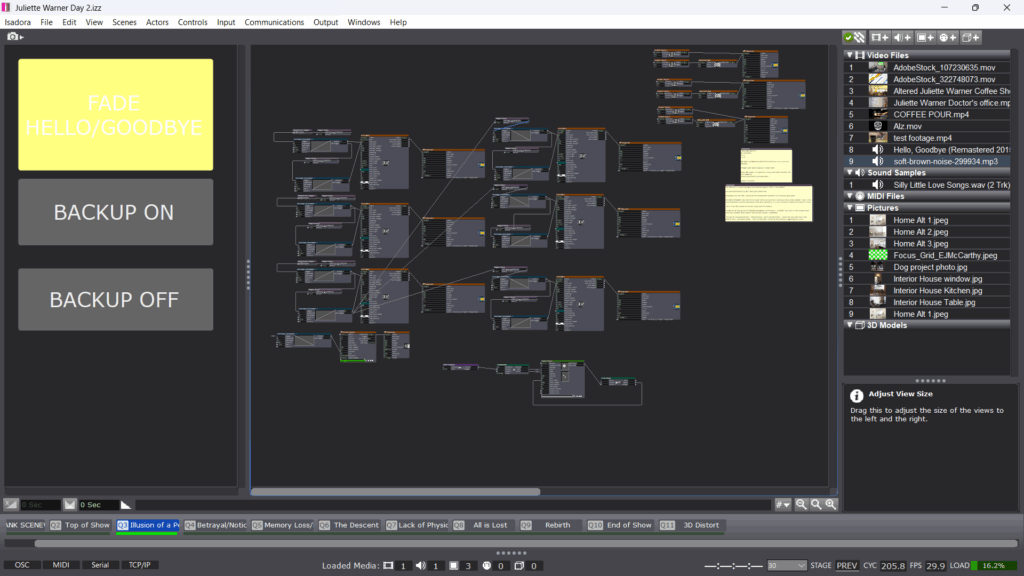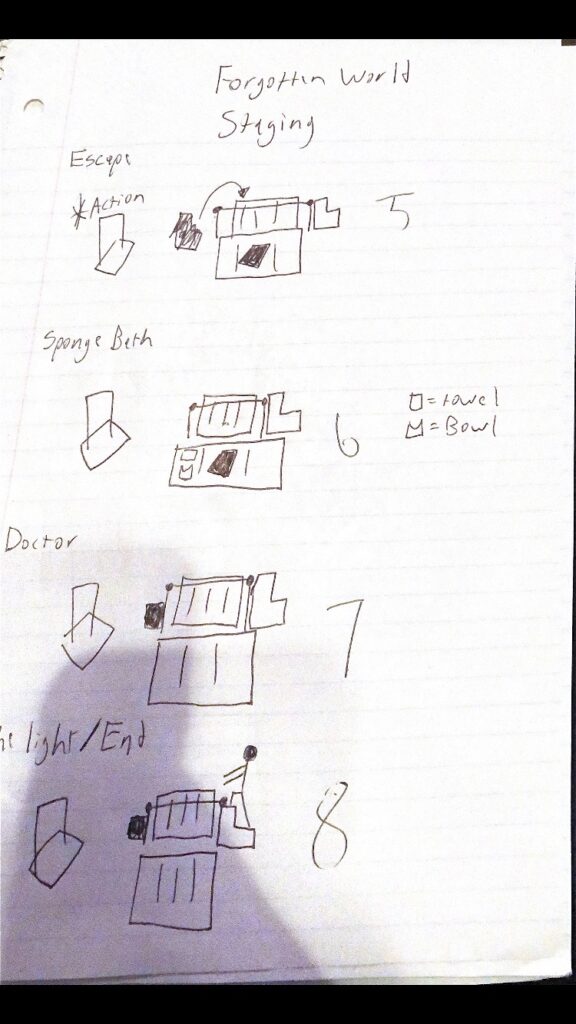Cycle Three: The Forgotten World of Juliette Warner
Posted: April 30, 2025 Filed under: Uncategorized Leave a comment »For my third cycle, I wanted to revisit my cycle one project based on the feedback I had received, which centered mostly on the audience’s relationship with the projections. One sticking point from that earlier cycle was that all three projectors featured the same projected surface. This choice was originally made as a preventative measure to keep Isadora’s load low. That being said, the first point of focus for my cycle three project was determining whether three separate projected video streams would be sustainable. Once I confirmed that they were, I began sourcing media for the entire script.
After gathering my media, I moved onto an element I’ve wanted to incorporate since cycle one but hadn’t felt fully ready to tackle, depth sensors. I used the Orbec sensor placed in the center of the room, facing down (bird’s-eye view), and defined a threshold that actors could enter or exit, which would then trigger cues. I accessed the depth sensor through a pre-built patch (thank you, Alex and Michael) in TouchDesigner, which I connected to Isadora via an OSC Listener actor. This setup allowed Isadora to receive values from TouchDesigner and use them to trigger events. With this in mind, I focused heavily on developing the first scene to ensure the sensor threshold was robust. I marked the boundary on the floor with spike tape so the performers had a clear spatial reference.
Outside of patch-building, I devoted significant time to rehearsing with three wonderful actors. We rehearsed for about three hours total. Because class projects sometimes fall through due to cancellations. as happened with my first cycle, I wanted to avoid that issue this time around. It was important to me that the actors understood how the technology would support their performances. To that end, I began our first rehearsal by sharing videos that illustrated how the tech would function in real time. After that, we read through the script and discussed it in our actor-y ways, and I explained how I envisioned the design unfolding across the show.
In our second rehearsal, we got on our feet. I defined entrances and exits based on where the curtains would part and placed mats to indicate where the bench would be in the Motion Lab. These choices helped define the shared “in-the-round” experience for both audience and performers.
Over the weekend, I worked extensively on my patch. The full script juxtaposes the Heroine’s Journey with the stages of Alzheimer’s, so I wanted the audience to know which stage they were in as the performance unfolded. Using a combination of enter-scene triggers, trigger delays, envelopes, and text-draw actors, I created a massive patch for each scene that displayed the corresponding stage. This was by far my biggest time investment.

When I was able to get into the lab space with my actors for a mini tech run, I realized that these title cards, which I had spent so much time on, were not serving the immersive experience and to be honest, they were ugly. The entire concept of the piece was to place the audience alongside Juliette on her journey, sharing her perspective via media. Having text over that media disrupted the illusion, so I cut the text patches and Isadora’s performance load improved as a result.
I spent another two hours between tech and performance fine-tuning the timing of scene transitions, something I had neglected earlier. This led to the addition of a few trigger delays for sound to improve flow.
When it came time to present the piece to a modest audience, I was surprisingly calm. I had come to terms with the idea that each person’s experience would be unique, shaped by their own memories and perspectives. I had my own experience watching from outside the curtains, observing it all unfold. There’s a moment in the show where Juliette’s partner Avery gives her a sponge bath, and we used the depth sensor to trigger sponge noises during this scene. I got emotional there for two reasons. First, the performer took his time, and it came across as such a selfless act of care, exactly as intended. Second, I was struck by the realization that this was my final project of grad school, an evolution of a script I wrote my first year at OSU. It made me appreciate just how much I’ve grown as an artist, not just in this class, but over the past three years.

The feedback I received was supportive and affirming. It was noted that the media was consistent and that a media language had been established. While not every detail was noticed, most of the media supported the immersive experience. I didn’t receive the same critiques I had heard during cycle one, which signaled a clear sense of improvement. One comment that stuck with me was that everyone had just experience theatre. I hadn’t considered how important that framing was. It made me reflect on how presenting something as theatre creates a kind of social contract, it’s generally not interactive or responsive until the end. That’s something I’m continuing to think about moving forward.
Once the upload is finished, I will include it below: